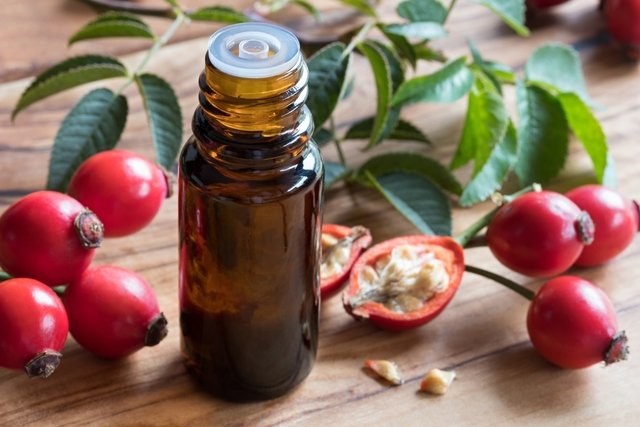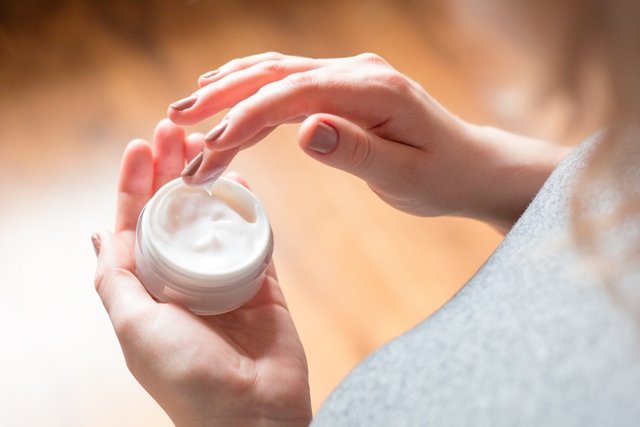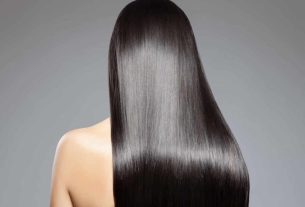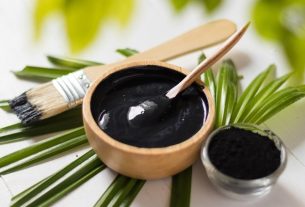Rosehip oil is an oil obtained from the seeds of the wild rosehip plant, which is rich in fatty acids, such as linoleic acid, as well as vitamin A and C, which have a regenerating effect and help maintain the integrity of the skin. , reducing stretch marks, keloids, blemishes, scars, wrinkles and expression lines.
Furthermore, rosehip oil is capable of reinforcing the production of collagen and elastin, which strengthens and gives firmness to the skin, and is also responsible for deeply nourishing it. It also has an antioxidant and anti-inflammatory effect, which enhances the healing process. The oil is also a great natural option for rebuilding hair strands, promoting deep hair hydration.
This oil can be found in pharmacies or in natural products and cosmetics stores. The concentration can vary from 2% to 10%, when combined in the composition of some creams or lotions, although it can also be found pure, with 100% concentration.

What is rosehip oil for?
Rosehip oil has several benefits and is normally indicated for:
1. Treat very dry and rough skin
Rosehip oil is especially recommended for treating very dry and rough skin, as it is rich in oleic and linoleic acid, as well as vitamin A, which has a regenerating and moisturizing effect on the skin.
2. Reduce skin blemishes
Rosehip oil helps reduce skin pigmentation and can be used to reduce skin blemishes, caused by acne, pimples or scars, for example.
3. Burn treatment
Rosehip oil has healing and skin regenerating properties, as well as anti-inflammatory action, due to the fatty acids in its composition, which can help in the treatment of 1st degree burns.
4. Post-operative and healing process
Due to the fatty acids and vitamins A and C in its composition, with healing properties, rosehip oil helps to regenerate the skin, in addition to stimulating the production of collagen and new skin cells, helping with the post-operative healing process. .
5. Relieve old scars
Rosehip oil can also help fade old scars or stretch marks as it reduces skin pigmentation, minimizing the appearance of old scars and fine lines on the skin.
6. Diaper Rash
Rosehip oil has anti-inflammatory properties and a regenerating action on the skin, in addition to reducing skin irritation and redness, promoting healing and increasing the skin’s protective barrier, and can be used for the prevention or treatment of diaper rash.
7. Psoriasis
Rosehip oil can be used on skin with psoriasis or other dermatoses, as it has a deep moisturizing action on the skin and stimulates cell regeneration, preventing excessive dryness of the skin, and can be used daily on skin with psoriasis or dermatosis.
8. Attenuate and disguise wrinkles and expression lines
Rosehip oil is rich in vitamin C, with antioxidant properties and stimulating the production of collagen and elastin for the skin, which helps to reduce and disguise wrinkles and expression lines.
Furthermore, this oil has moisturizing properties, preventing skin dryness, which also helps to reduce and disguise wrinkles and expression lines.
9. Prevent premature skin aging
Rosehip oil can also help prevent premature skin aging, as the vitamin C present in the oil has antioxidant action, which prevents damage caused by free radicals to skin cells.
10. Prevent stretch marks during pregnancy
Rosehip oil can also be used during pregnancy with the aim of preventing the development of stretch marks, in which case it is important to use it with the advice of a dermatologist.
11. Moisturize your hair
Rosehip oil can be used on dry and brittle hair, to rebuild strands, hydrate, promote shine and control frizz, and can be part of the hair schedule.
How to use
Rosehip oil can be used on both skin and hair:
1. Rosehip oil for face
To use rosehip oil on your face, you can apply a few drops to your face and massage gently, 1 to 2 times a day.
Another way to use rosehip is to add it to anti-wrinkle creams with the aim of hydrating, softening and preventing the appearance of wrinkles and expression lines on the skin.
Ingredients
- 5 mL of rosehip essential oil;
- 20 mL of coconut oil;
- 30 mL of beeswax;
- 1 ampoule of vitamin E;
- Glass jar or jar with lid.
Preparation mode
Place the coconut oil and beeswax in a pan and heat in a bain-marie, mixing regularly with a spatula, until the two ingredients are mixed. After the coconut oil and beeswax are mixed, add the rosehip oil and the vitamin E ampoule, mix well and let it cool. Store in the refrigerator.
This cream can be applied several times a day as needed, and is especially recommended to be applied to the face at night before going to sleep.
Furthermore, to make the cream more liquid, you can add 30 mL of coconut oil and just 20 mL of beeswax or, on the other hand, if you prefer a thicker cream, just add 40 mL of beeswax and just 10 mL of beeswax. 15 mL of coconut oil.
2. Rosehip oil for the body
To use rosehip oil on the skin, it is recommended that a few drops be applied directly to the skin, massaging with gentle circular movements for 2 to 3 minutes, until completely absorbed.
The oil can be applied 1 to 2 times a day, especially in drier areas or areas with scars, stretch marks, wrinkles or expression lines, for example, as needed.
If used to prevent stretch marks, the dermatologist may recommend applying it at least twice a day.
3. Rosehip oil on hair
Rosehip oil can be used throughout the hair, from the root of the hair, applying a few drops to the scalp, and massaging with circular movements for 5 minutes and along the entire length of the hair, repeating at least once per week.
Additionally, you can prepare a moisturizing hair mask at home.
Ingredients
- 2 to 3 drops of rosehip oil;
- Hair hydration cream.
Preparation mode
Add the drops of rosehip oil to a little hair moisturizing cream, and to damp hair for 15 to 20 minutes, then removed with your usual shampoo and conditioner.
You can use oil purchased at a pharmacy or health food store, as well as prepared at home.
How to make rosehip oil at home
It is possible to prepare rosehip oil at home to nourish and give luminosity to the skin, for this you will need:
Ingredients
- 30 to 40 grams of rosehip seeds;
- Almond oil;
- Glass jar or jar with lid;
- Dropper.
Preparation mode
Firstly, it is recommended to cut the rosehip seeds in half and then place them in a clean, dry glass jar.
Then add enough almond oil to cover all the seeds, cover the bottle and let it rest for approximately 20 days. After this time, strain the oil, transfer it to a dropper and store away from heat and direct light.
Who shouldn’t use
To date, rosehip oil is not indicated for use on open wounds and, therefore, is contraindicated in these cases and should only be used on intact skin.

Sign up for our newsletter and stay up to date with exclusive news
that can transform your routine!
Warning: Undefined array key "title" in /home/storelat/public_html/wp-content/plugins/link-whisper-premium/templates/frontend/related-posts.php on line 12
Warning: Undefined array key "title_tag" in /home/storelat/public_html/wp-content/plugins/link-whisper-premium/templates/frontend/related-posts.php on line 13




